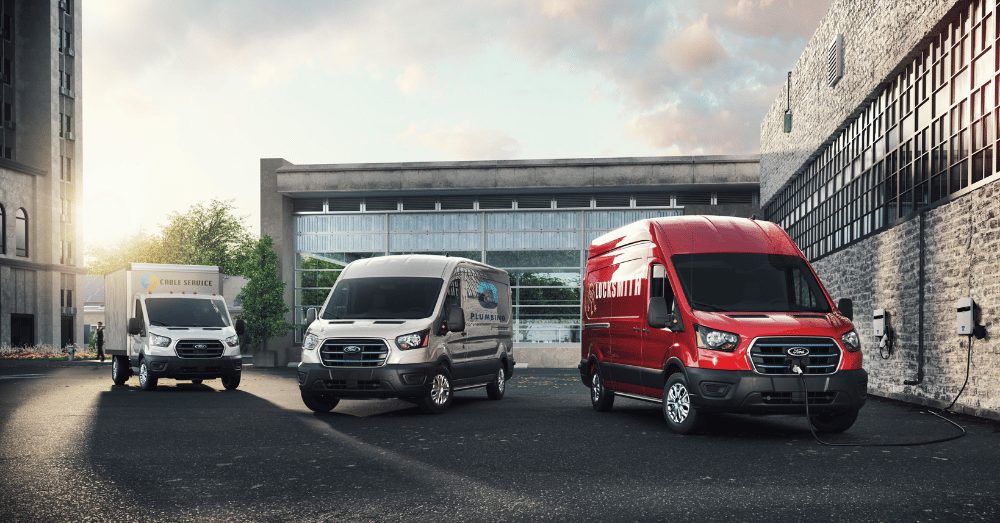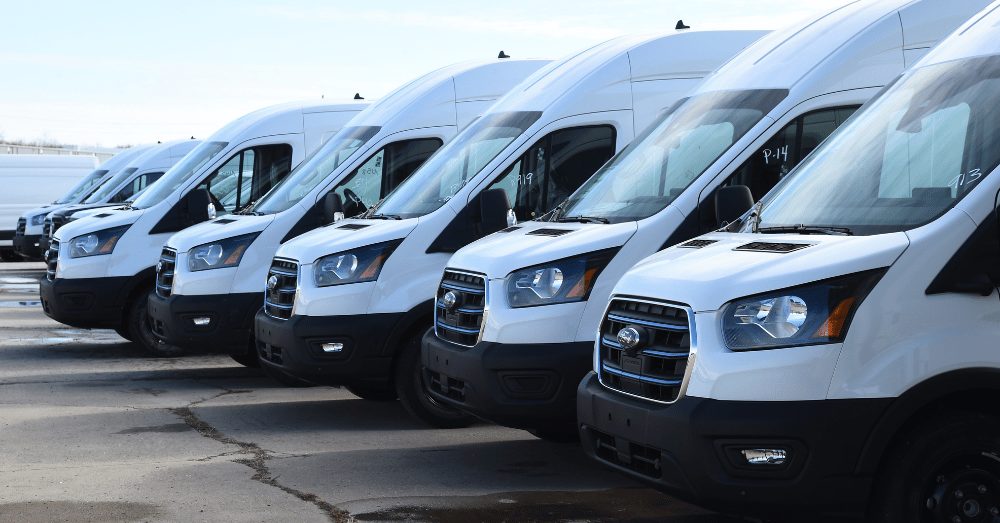Walk into any busy delivery depot these days and you’ll notice something different. The rumble of diesel engines is getting quieter as electric vans take over routes from downtown offices to suburban neighborhoods. Ford has jumped into this electrified van shift with the E-Transit and E-Transit Custom: two vans that keep your cargo moving while your fuel costs stay put.
- The E-Transit delivers up to 159 miles per charge in North America, while Europe’s E-Transit Custom reaches 209 miles with smart battery management that works for real-world driving conditions.
- Both models maintain serious cargo capacity, with the larger E-Transit handling up to 3,997 pounds of payload and the Custom carrying over 2,200 pounds without breaking a sweat.
- Fast charging can add 45-67 miles of range in just 15 minutes, which means coffee breaks actually help your productivity instead of just your caffeine levels.
Two Different Approaches to Electric Work
Ford took a practical approach when designing these electric vans. The E-Transit handles the heavy-duty American market where bigger loads and longer distances matter most. Meanwhile, the E-Transit Custom serves European businesses dealing with narrow streets and tight parking spots where smaller dimensions make all the difference.
The E-Transit packs an 89kWh battery with a 266-horsepower electric motor. That’s plenty of power for construction crews hauling tools or delivery services handling furniture. The European Custom uses a 64kWh battery setup that still produces 134 horsepower in standard form: perfect for city deliveries and service calls.
Both vans run whisper-quiet compared to their diesel cousins. Early morning deliveries won’t wake up entire neighborhoods anymore, which opens up new time slots for businesses that couldn’t run routes at dawn before.
The E-Transit Delivers Range That Works for Daily Routes
Most commercial vans in America average 74 miles per day according to Ford’s research. The E-Transit goes well past that mark with up to 159 miles per charge, giving fleet managers breathing room for unexpected stops or traffic delays.
Your actual range depends on which version you pick. Low-roof models hit 159 miles while high-roof versions reach 143 miles due to wind resistance. If you’re running city routes with lots of stop-and-go traffic, you’ll probably do better than the EPA estimates since electric motors recapture energy when braking.
Over in Europe, the E-Transit Custom delivers 209 miles of official range. Real-world testing shows it uses about 2.8kW per mile during normal loading, which translates to reliable daily performance for most small businesses.
Cargo Space Stays Put
The biggest worry when switching to electric usually involves losing cargo room to batteries. Ford’s engineers positioned the battery packs low in the chassis, keeping load floors flat and storage areas intact.
Cargo capacity ranges from 3,249 pounds in the basic E-Transit up to 3,997 pounds in cutaway models. The high-roof extended version offers 487 cubic feet of space, which is enough for most plumbing supplies, restaurant equipment, or Amazon packages you can legally carry.
The E-Transit Custom keeps the same interior dimensions as the diesel version. The L1 model measures 2,602mm from doors to bulkhead, actually beating most electric competitors for usable load length. Ford clearly understood that businesses can’t sacrifice hauling capacity just to go green.

E-Transit Charging Options That Make Sense
Charging determines whether electric vans work for your business or not. The 2024 E-Transit handles up to 176kW of charging power. Fifteen minutes at a DC fast charger adds 67 miles of range, which is plenty of time for drivers to grab lunch and come back ready for afternoon routes.
Overnight charging works even better for most fleets. Using Ford’s 80-amp charging station, the E-Transit goes from empty to full in about six hours. That’s perfect for depot charging where vans sit overnight anyway.
The E-Transit Custom charges at speeds up to 125kW, taking just 41 minutes to go from 15% to 80% battery. For businesses running multiple shifts or covering long routes, this speed keeps operations moving without long breaks.
Ford also provides access to North America’s largest public charging network for E-Transit owners. The BlueOval Charge Network eliminates the hassle of signing up with multiple charging companies or downloading different apps for each station.
Built-In Power for Tools and Equipment
Pro Power Onboard sets these Ford vans apart from most competitors. This system provides 2.4kW of household power through regular outlets while driving, parked, or charging. Contractors can run power tools, lights, and computers directly from the van instead of hauling separate generators around.
The European E-Transit Custom offers similar capability with its 2.3kW Pro Power system. Electricians can run power tools between job sites, HVAC technicians can operate diagnostic equipment, and delivery drivers can keep refrigerated goods cold without idling the van.
This feature becomes especially valuable on remote job sites where grid power isn’t available. Instead of renting generators or bringing extra equipment, your van becomes a mobile power station that’s always ready when you need it.
Technology That Actually Helps
FordPro Telematics comes standard and gives fleet managers real visibility into their operations. You can track charge levels, monitor driving habits, see route efficiency, and even get alerts if someone breaks into your van after hours.
The E-Transit Custom gets particularly nice tech features. A 13-inch touchscreen runs Ford’s SYNC 4 system with 5G connectivity for better fleet management. The steering wheel actually tilts flat and includes a clip-on tray, turning your cab into a mobile office when needed.
For delivery drivers who spend time completing paperwork between stops, this mobile desk setup beats trying to balance clipboards on your lap. Small details like this show Ford actually talked to people who use these vans for work.
E-Transit Configurations for Different Jobs
The E-Transit comes in three roof heights and two body lengths. You can get cargo van, cutaway, or chassis cab versions depending on your needs. Food truck operators need different setups than Amazon delivery drivers, and Ford accommodates both.
European customers get even more choices with the E-Transit Custom. Van, double-cab-in-van, Kombi (up to eight passengers), and MultiCab (two-seat second row with full cargo area) configurations handle different business requirements. Small companies that need to haul both people and cargo can find exactly what works.
Ford also added four trade-specific packages for 2025: Electrician Trade, General Contractor, HVAC Trade, and Foldable Shelving. These factory packages include the shelving, tool storage, and power outlets that specific trades actually use instead of making contractors retrofit everything after purchase.
Operating Costs That Make Business Sense
Electric vans cost more upfront but save money over time through lower operating expenses. Ford estimates 40% lower operating costs over eight years compared to gas-powered Transits. This comes from cheaper electricity versus gasoline, reduced maintenance needs, and fewer moving parts that break.
Maintenance intervals tell the real story. The 2024 E-Transit gets service every two years with unlimited mileage, compared to diesel vans that need attention every few months. For businesses running multiple vehicles, this reduction in downtime and service visits adds up quickly.
Electric motors also last longer than combustion engines. Most electric drive systems are good for 200,000+ miles with minimal maintenance, while diesel engines typically need major service around 150,000 miles.
What This Means for Your Business
Ford built these electric vans for companies that can’t afford to compromise on capability. The E-Transit handles American-sized loads and distances while the E-Transit Custom provides European efficiency and maneuverability. Both prove that electric doesn’t mean giving up the work-ready attitude that made Transit vans popular worldwide.
Charging infrastructure keeps expanding, operating costs stay lower than diesel, and maintenance becomes less frequent. These aren’t just environmental statements; they’re business tools that can improve your bottom line while preparing for regulations that increasingly favor zero-emission vehicles in city centers.
Whether you’re running one van or managing hundreds, both E-Transit models offer the reliability and capability your business needs. The question isn’t whether electric commercial vehicles make sense anymore: it’s which configuration works best for your specific operation.
This post may contain affiliate links. Meaning a commission is given should you decide to make a purchase through these links, at no cost to you. All products shown are researched and tested to give an accurate review for you.




